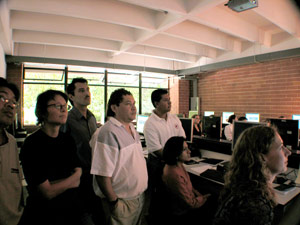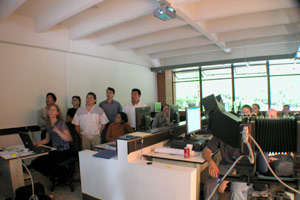Digital Photography 101: Summer 2005, in person at UFM
How to Choose and Use a Digital Camera
Digital Photography for Beginners through Intermediate into Advanced
Distinctions between Nikon D100-Nikon D70, Foveon SD9, Fuji, Canon Digital Rebel & EOS, and Kodak 35mm
actual distinctions between tri-linear scan backs and medium format digital backs
Distinctions between CCD and CMOS sensors (noise, etc)
true difference between one-shot and multi-shot digital systems
full range of pros and cons of digital vs traditional film
If you realize there is still life left for traditional film, and wish to learn digital photography without abandoning 35mm Kodachromes, 120 Fujichrome, or 4x5 Ektachrome quality, then you will feel at home with Nicholas, a photographer steeped in Nikon, Leica, Hasselblad, and Linhof experience.

FLAAR UFM introductory course on digital photography.
We all start out with simple point-and-shoot digital cameras: Canon, Sony, Fuji, Nikon CoolPix. Nicholas began with a Sony Mavica, moved through three models of Nikon CoolPix, and now uses a Nikon D100 and Sigma SD9. He has used medium format and large format digital cameras also, so you will learn the pros and cons of every kind of camera. Dr Hellmuth has tested medium format (on Hasselblad) and large format digital cameras for their manufacturers too. Dr Hellmuth has been photographing in Guatemala for over 40 years.
How many other instructors of digital photography have written their entirely own textbook when they noted that normal books were not quite thorough enough?
The reason you can learn from FLAAR reports is because every statement in Nicholas Hellmuth’s instructional materials is based on a single set of premises:
What class of camera is optimal for the kind of photography I do:
35mm, if so, which brand?
*
medium format, if so, 1-shot vs 3-shot vs macro-scan?
*
large format, what are the pros and cons of tri-linear systems?
*
or do I need more than one format (we actually use all three).
What lens, back, filter, tripod, or accessory is
The most practical?
*
The best designed and constructed for ease of use?
*
Is a good value for its price?
*
Will last for years and then still have resale value?
*
Will do its job effectively and allow me to concentrate on the shoot?
Which lighting that I am already used to from traditional photography
Still works with digital cameras?
*
Does not function whatsoever with tri-linear scan backs?
*
Would be a disaster with film but is surprisingly the best choice for digital?
*
I never heard about CD, HQI and HDI lighting before? Why is this turning out to be the certified kinds of lighting that some museums and libraries will accept?
 |
| Class during introductory course for Digital Photography from FLAAR UFM. |
FLAAR has dedicated over 30 years to traditional photography with Leica, Nikon, Rollei, Hasselblad, and Linhof large format up to 8x10 chromes. So we know the world of 35mm negatives and slides, the world of medium format and larger. Yet we have made the transition to digital photograph, and thereby can assist you to enter digital photography too.
Most of the people who sign up say they were unable to find any other course where the instructor so clearly had personal experience in all four levels of digital cameras (point-and-shoot, 35mm, medium format, and large format).
Once they sign up and take the course, they realize that most universities do not have the range of equipment of FLAAR. Plus Dr Hellmuth also taught at the University of Malta. Each university has additional equipment and different kinds of studio lighting. So Professor Hellmuth has seen it all.
In addition to the hands-on course in person in Guatemala in the summer (taught in Spanglish), we have the on-line course available anywhere in the world.
Here is the information about the on-line Distance Learning version of the course:
Digital Photography Course for the Beginner, Intermediate and Advanced
* Dates: 2005
* Open to the public, you do not have to be a student
* Taught on line
* Lectures in English but you can communicate auf Deutsch or en Español
* Course Outline for DP 101 and 201:
* DP 101 - Achieving Quality in Digital Photography (January-February 2005)
* DP 201 - Taking Digital Photography to the Next Level (March-April 2005)
Most recently updated November 17, 2004.
Previously updated Jan 24, 2001, updated March 7, 2002, updated Dec 16, 2002, updated Mar. 21 2003, updated Apr 28 2003.